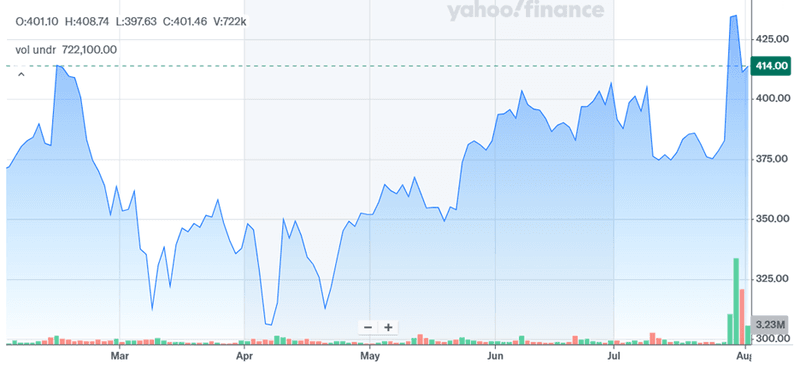CyberArk’s $20 Billion Courtship: Is Palo Alto Buying the Future of Identity?

Palo Alto Networks (NASDAQ:PANW) is reportedly in advanced talks to acquire CyberArk Software (NASDAQ:CYBR) in a deal that could exceed $20 billion, marking one of the biggest technology takeovers of 2025. The Israeli identity security company saw its shares surge over 13% following the Wall Street Journal’s July 29 report, while Palo Alto’s stock dropped 5%, signaling investor caution around the scale of the transaction. If completed, the deal would be in the same league as Alphabet’s $32 billion acquisition of Wiz earlier this year as a signal of escalating consolidation in the cybersecurity space. Palo Alto has consistently emphasized the need for integrated, end-to-end security platforms that can counter increasingly sophisticated threats—especially those amplified by AI. CyberArk’s leadership in privileged access management (PAM), identity governance, and machine identity protection positions it as a valuable asset in this broader strategic push. Let us analyze the biggest factors as to why CyberArk could be a strong fit for Palo Alto’s platform ambitions.
Identity Is The Cybersecurity Perimeter
Identity has become the most targeted and consequential security layer, with adversaries shifting their tactics from breaching networks to exploiting credentials—both human and machine. CyberArk has built its platform around deterministic, preventative identity controls rather than probabilistic, detection-based approaches. Its core capabilities in PAM secure high-risk accounts through credential vaulting, session monitoring, and access governance, covering traditional IT users and cloud-native roles like developers and DevOps teams. The company has also expanded into workforce identity security, layering secure web sessions and workforce password management atop its SSO and MFA solutions. These tools are now critical, as enterprises confront complex hybrid environments and AI-enhanced phishing threats. Palo Alto’s current identity-related efforts largely integrate with its SOC-oriented portfolio (EDR, XDR), which operates reactively. Acquiring CyberArk would give Palo Alto a much stronger identity pillar—enabling it to offer comprehensive, proactive controls across all identity types. This aligns with Nikesh Arora’s thesis on collapsing fragmented security stacks into consolidated platforms built on customer trust. Integrating identity as a first-class control—not just an alert signal—would allow Palo Alto to compete more effectively against players like Microsoft, who have deep identity integrations in their ecosystems. Additionally, identity-centric security is now a board-level concern, and a platform that integrates access protection with endpoint and network controls could become essential as customers pursue Zero Trust architectures.
Strategic Entry Into IGA & Machine Identity Security
CyberArk’s recent acquisition of Zilla Security provided it with an entry point into identity governance and administration (IGA), a segment that complements its traditional PAM offerings. IGA capabilities are critical for managing lifecycle events—such as joiners, movers, and leavers—and ensuring that access rights remain aligned with organizational policies. Traditional IGA vendors have struggled with slow deployment times and operational complexity, creating an opportunity for CyberArk’s modern, lightweight, AI-enhanced governance solutions. Palo Alto has not had a footprint in this space, and the addition of CyberArk’s governance layer would allow it to deliver full-cycle identity security—from access provisioning and entitlements to revocation and compliance. More importantly, CyberArk also addresses machine identity—a rapidly emerging concern as enterprises deploy more automated workloads, cloud services, and agentic AI bots. Its Venafi acquisition gave it certificate lifecycle management and secrets management tools that protect nonhuman credentials, a need that has intensified as certificate lifespans shrink and workload sprawl increases. Palo Alto’s current portfolio lacks these capabilities, leaving a gap as customers increasingly demand machine identity controls. Through CyberArk, Palo Alto can offer integrated governance and security across both human and machine identities, allowing it to address modern enterprise needs holistically. This positions it ahead of rivals like CrowdStrike, whose identity ambitions still focus mainly on just-in-time access from a detection standpoint, and IBM, which has fragmented offerings across multiple legacy platforms.
Expansion Opportunity Across Installed Base
CyberArk’s business model is inherently conducive to account expansion. Initial deployments often focus on the most critical PAM use cases, such as protecting domain admins or securing access to sensitive databases. However, over time, most customers expand usage across additional systems, developer environments, cloud infrastructure, and workforce roles. According to CyberArk’s management, many large customers have established multi-year adoption roadmaps—moving from IT to DevOps to workforce, and ultimately to machine identity. This built-in tail of recurring upsell and cross-sell creates durable revenue momentum. Furthermore, CyberArk often lands with multiple products—PAM and either endpoint or workforce identity—giving it a broader initial foothold. Integrating CyberArk into Palo Alto’s platform would not only enhance Palo Alto’s own identity value proposition but also unlock additional monetization opportunities across both companies’ installed bases. Palo Alto could offer identity security to its firewall, XDR, and Prisma Cloud customers while upselling its own capabilities to CyberArk’s 10,000+ customers, many of whom are enterprise-scale organizations. This cross-sell motion could strengthen net retention rates, reduce customer acquisition costs, and reinforce Palo Alto’s value in boardroom-level security conversations. Importantly, CyberArk’s consultative, enterprise-focused go-to-market organization complements Palo Alto’s platform-selling motion, offering high leverage for pipeline development and renewals.
Trust Consolidation & Platform Stickiness
Nikesh Arora has repeatedly emphasized a strategic concept he terms “consolidation of trust,” where security buyers streamline their vendor relationships in favor of fewer, more strategic partners. In a world with rising security budgets but shrinking tolerance for complexity, enterprises are gravitating toward platforms that can deliver multiple controls with integrated intelligence, unified policy management, and shared infrastructure. CyberArk fits neatly into this consolidation trend. Its architecture supports multiple identity types—human, machine, workforce, and AI agents—with shared services and user experiences that enable scalable deployment. The company’s proactive, preventive orientation also differentiates it from vendors whose identity features are largely bolted onto detection tools. In areas like agentic AI, where bots with both human and machine characteristics will increasingly need managed identities and access policies, CyberArk’s platform is already preparing for these next-generation needs. Customers want fewer but deeper vendor relationships, and CyberArk is often viewed as the identity anchor in such conversations. By acquiring CyberArk, Palo Alto would not just gain technology—it would gain a position of trust in one of the most sensitive areas of cybersecurity. That trust is difficult to earn and harder to buy; CyberArk’s long-standing customer relationships and roadmap alignment make it uniquely synergistic with Palo Alto’s strategic vision. Furthermore, a platform offering identity, endpoint, network, and cloud security under one umbrella could become significantly more defensible over time.
Final Thoughts

Source: Yahoo Finance
While the strategic rationale for acquiring CyberArk is clear, the financial implications are complex. Palo Alto’s current LTM valuation multiples—19.92x price-to-sales and 19.22x EV/revenue—reflect elevated market expectations that leave limited margin for error. Its LTM EV/EBITDA exceeds 6,400x due to depressed earnings, suggesting little near-term accretion unless substantial cost or revenue synergies are realized. CyberArk, though strategically aligned and deeply embedded in enterprise workflows, would add integration complexity and extend Palo Alto’s exposure to identity-specific go-to-market dynamics. Additionally, overlapping investor concerns about dilution and execution risks, as evidenced by the 5% stock drop post-report, suggest that any deal would need to be carefully structured. The deal’s outcome remains uncertain, but what’s undeniable is the growing centrality of identity in cybersecurity and the strategic appeal of a platform like CyberArk’s in that evolving landscape.



